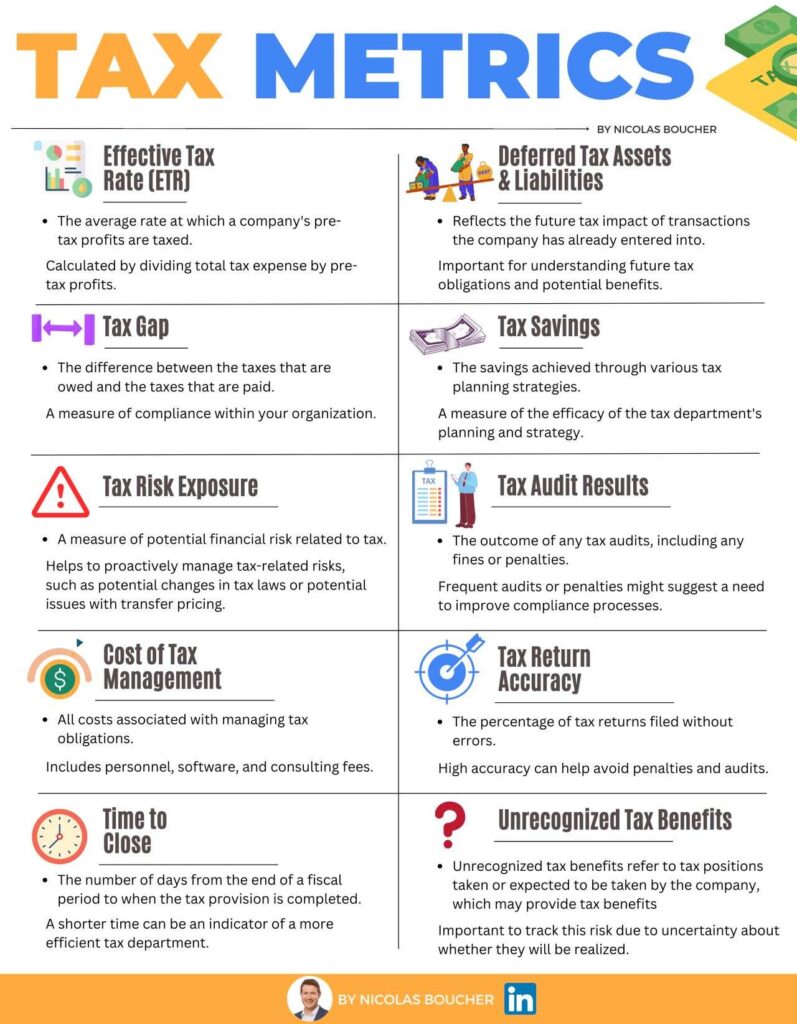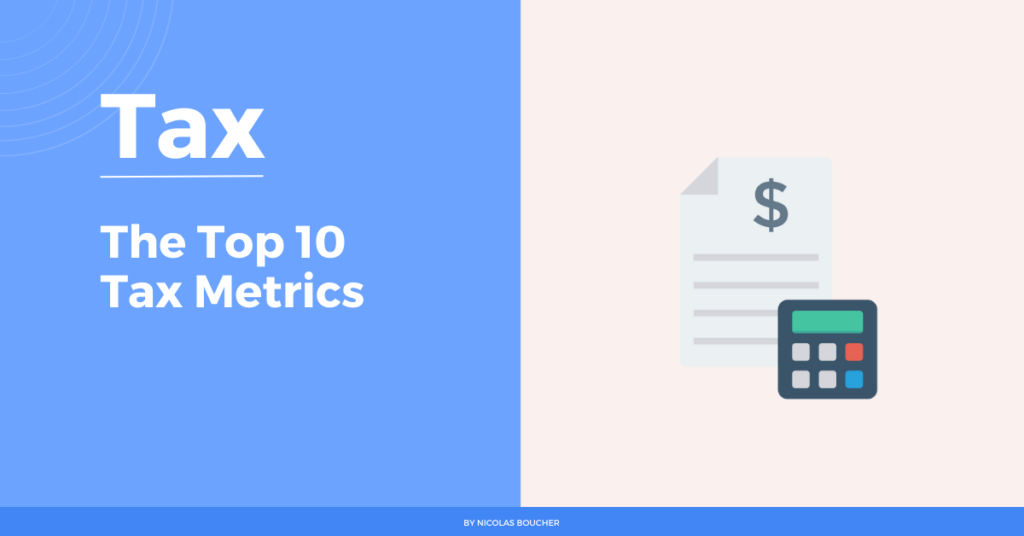Do you know the top tax metrics?
Tax management plays a crucial role in the financial success of any organization.
It is essential to understand the key metrics that can help evaluate the performance of the tax department.
In this blog post, we will explore the top 10 tax metrics that every CFO and tax team should follow to ensure efficient tax planning, compliance, and risk mitigation.
Top 10 Tax Metrics
Here are the crucial tax metrics for evaluating the performance of your tax department.

#1: Effective Tax Rate (ETR)
The Effective Tax Rate (ETR) is the average rate at which your company’s pre-tax profits are taxed. It serves as a key indicator of tax planning efficiency.
By analyzing the ETR over time and comparing it with industry peers, you can gain insights into the effectiveness of your tax strategies.
A lower ETR suggests effective tax planning, while a higher ETR may indicate potential areas for improvement.
Monitoring the ETR helps optimize tax liabilities and enhance overall financial performance.
#2: Tax Gap
The Tax Gap measures the difference between the taxes that are owed and the taxes that are actually paid.
Above all, it provides a clear picture of compliance levels within your organization.
By comparing your tax liabilities with the amount paid, you can identify potential areas of tax leakage or underpayment.
Therefore, monitoring the Tax Gap allows you to implement corrective measures, strengthen compliance processes, and minimize the risk of penalties, interest, or reputational damage.
#3: Tax Return Accuracy
Tax Return Accuracy is the percentage of tax returns filed without errors. High accuracy in tax return preparation is crucial to avoid penalties, audits, and reputational risks.
By tracking this metric, you can ensure that your tax returns are prepared correctly. Tha will minimize the potential for errors, omissions, or inconsistencies.
Regular reviews, internal controls, and training programs for tax professionals can help improve tax return accuracy, leading to smoother tax compliance processes.
#4: Cost of Tax Management
The Cost of Tax Management encompasses all expenses associated with managing tax obligations, including personnel salaries, tax software, consulting fees, and other administrative costs. It is essential to optimize these costs while maintaining compliance and accuracy.
By monitoring and evaluating the cost of tax management, you can identify opportunities for streamlining processes, leveraging technology, or reallocating resources to achieve cost efficiencies.
Effective cost management allows you to allocate resources more strategically and maximize the value generated by your tax department.
#5: Time to Close
Time to Close is a metric that measures the number of days it takes to complete the tax provision process from the end of a fiscal period. A shorter time to close indicates a more efficient tax department.
By streamlining workflows, improving data collection and analysis, and leveraging technology solutions, you can reduce the time required to finalize the tax provision.
Therefore, timely completion of the tax provision allows for more accurate financial reporting, enhances decision-making, and facilitates effective tax planning.
#6: Deferred Tax Assets & Liabilities
Deferred Tax Assets and Liabilities reflect the future tax impact of transactions your company has already entered into. These arise due to differences between financial accounting rules and tax laws.
Most importantly, monitoring and analyzing deferred tax assets and liabilities is crucial for understanding future tax obligations and potential benefits.
By tracking changes in these balances over time, you can assess the impact of business transactions on future tax liabilities, identify tax planning opportunities, and optimize tax positions.
#7: Tax Savings
Tax Savings quantifies the benefits achieved through effective tax planning strategies. It measures the amount of tax reduction or deferral resulting from legitimate tax planning initiatives.
By actively seeking opportunities to minimize tax liabilities, leverage available tax incentives, and optimize structures and transactions, you can generate substantial tax savings for your organization.
As a result, tracking tax savings provides tangible evidence of the success of your tax department’s planning and strategy. And also, to the overall financial performance.
#8: Tax Audit Results
Keeping track of the outcome of tax audits is essential to assess the effectiveness of compliance processes. But also for the overall risk exposure of your organization. Monitoring tax audit results includes reviewing any fines, penalties, or adjustments resulting from tax examinations conducted by tax authorities.
Consequently, frequent audits or penalties may indicate the need for improvements in compliance practices, record keeping, or internal controls.
By analyzing the results of tax audits, you can identify areas of non-compliance, understand the root causes of issues, and take corrective actions to enhance your tax compliance processes.
As a result, proactively addressing any deficiencies or weaknesses identified in tax audits helps minimize future audit risks and ensures ongoing compliance with tax regulations.
#9: Unrecognized Tax Benefits
Unrecognized Tax Benefits refer to the benefits from tax positions that your company has taken, or expects to take, on a tax return but haven’t been recognized in the financial statements due to uncertainty.
Moreover, these arise when there is a difference in interpretation between your company and the tax authorities regarding tax positions or when the potential outcome of a tax dispute is uncertain.
But, it is crucial to monitor these benefits!
Why?
Because they can have a significant impact on your financial statements and tax liabilities.
Finally, regularly assessing the status and potential risks associated with unrecognized tax benefits enables you to mitigate potential financial and reputational risks, ensure accurate financial reporting, and address any potential tax exposures.
#10: Tax Risk Exposure
Tax Risk Exposure measures the potential financial risk associated with tax, such as potential changes in tax laws, regulatory developments, or issues with transfer pricing.
Therefore, proactive management of tax-related risks is essential for minimizing the impact on your organization’s financial position and reputation.
Also, by monitoring changes in tax laws, staying informed about regulatory developments, and assessing potential risks, you can develop appropriate risk mitigation strategies.
Additionally, this may involve engaging with tax advisors, implementing robust internal controls, conducting transfer pricing reviews, and maintaining open lines of communication with tax authorities.
However, managing tax risks effectively helps protect your organization from unexpected financial burdens and ensures compliance with evolving tax regulations.
Why Are They Important?
Effective tax management goes beyond mere compliance; it involves optimizing costs, minimizing risks, and maximizing tax benefits.
Furthermore, by tracking and analyzing these tax metrics, organizations can identify areas of improvement, make informed decisions, and enhance their overall financial performance.
The Bottom Line – Evaluate Your Tax Management Successfully
To effectively manage tax obligations and mitigate risks, organizations must track and evaluate these top 10 tax metrics.
Therefore, by monitoring tax planning efficiency, compliance levels, cost optimization, and risk exposure, finance professionals, CFOs, and tax teams can make informed decisions, improve performance, and drive financial success in a dynamic tax landscape.
Implementing appropriate strategies based on these metrics will help organizations optimize tax outcomes, ensure compliance, and enhance overall financial performance.
Most importanly, unlock the power of ChatGPT for finance professionals. Claim this guide to learn how to use ChatGPT to improve your performance and enhance your analysis and decision-making skills.
Finally, you can subscribe to my newsletter to receive more tips and insights about Finance, FP&A and Controlling.
Key Takeaways
- Effective Tax Rate (ETR) measures tax planning efficiency.
- Tax Gap indicates compliance levels and potential tax leakage.
- Tax Return Accuracy reduces the risk of penalties and audits.
- Cost of Tax Management optimization ensures compliance and accuracy.
- Time to Close reflects the efficiency of the tax department.
- Deferred Tax Assets & Liabilities assist in managing future tax obligations and benefits.
- Tax Savings quantifies the success of tax planning strategies.
- Tax Audit Results highlight the effectiveness of compliance processes.
- Unrecognized Tax Benefits require attention for accurate financial reporting.
- Tax Risk Exposure necessitates proactive management for risk mitigation.

